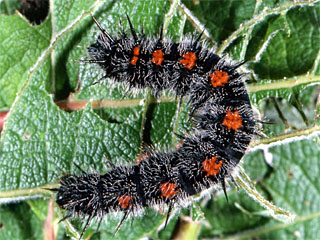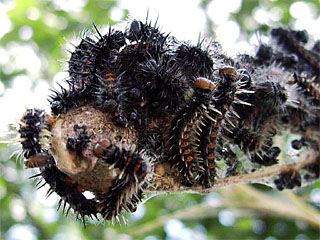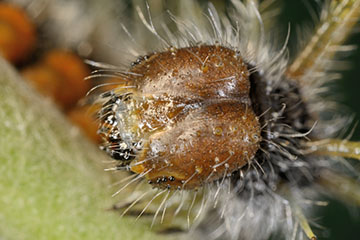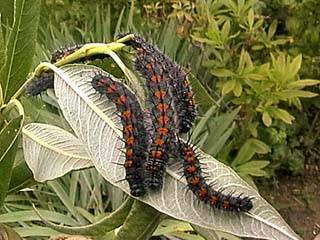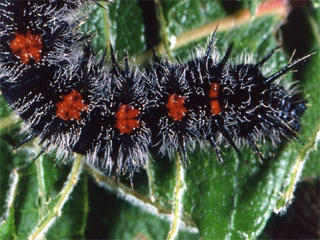 Camberwell BeautyNymphalis antiopa (Linnaeus, 1758)Mourning CloakCamberwell Beauty
Camberwell BeautyNymphalis antiopa (Linnaeus, 1758)Mourning CloakCamberwell Beauty
Camberwell Beauty (Nymphalis antiopa)-caterpillar
[Breeding image]
Breeding:
Dieter StüningDieter Stüning; Bonn,  GermanyBonn,
GermanyBonn,  Germany
Germany Germany
Germany
The caterpillar of the  Camberwell BeautyNymphalis antiopa (Linnaeus, 1758)Mourning CloakCamberwell Beauty is black in colour. In the later stages of development, the caterpillar has large red spots on the upper side and pointed spines.
Camberwell BeautyNymphalis antiopa (Linnaeus, 1758)Mourning CloakCamberwell Beauty is black in colour. In the later stages of development, the caterpillar has large red spots on the upper side and pointed spines.
On the appearance of the caterpillar of the  Camberwell BeautyNymphalis antiopa (Linnaeus, 1758)Mourning CloakCamberwell Beauty's, Charles Sedgwick Minot (1852–1914)Charles Sedgwick Minot writes in Minot, 1886 - Zur Kenntniss der Insektenhaut:
Camberwell BeautyNymphalis antiopa (Linnaeus, 1758)Mourning CloakCamberwell Beauty's, Charles Sedgwick Minot (1852–1914)Charles Sedgwick Minot writes in Minot, 1886 - Zur Kenntniss der Insektenhaut:
In the cosmopolitan Vanessa antiopa, almost the entire skin is covered with cones. The caterpillar bears hairs of two forms, namely smaller dark ones next to larger ones, which retain only a faint brownish colour after treatment with potassium hydroxide. These protrude, each from a round, colourless, cone-free field; those, on the other hand, allow the cones to reach their bases. The cones are about the same size as in Lavinia, but they are less pointed and are also characterised by the fact that the number of ridges is usually six, a ratio that is all the more striking because the ridges are darker than the other parts of the coloured field. Now and again there are places where the colour has diminished considerably, and where consequently only the stripes radiating from the tip corresponding to the ridges are visible; when looking at this picture, one involuntarily thinks of a colony of misshapen starfish.
In 1746 August Johann Rösel (1705-1759)August Johann Rösel names the caterpillar of the then nameless summer bird the large gregarious thorny caterpillar with yellow-red spots .He noted that it is also called the sociable because it can always be found in company with other caterpillars of its kind.
August Weismann (1834-1914)August Weismann counted the spines of the head and the 12 body segments and compared them with other Vanessen1 Weismann, 1876 - Studien zur Descendenz-Theorie II. Über die letzten Ursachen der Transmutationen:
| Range | Thorns |
|---|---|
| Head | 0 |
| Segment 1 | 0 |
| Segments 2-3 | 4 |
| Segments 4-5 | 6 |
| Segments 6-11 | 7 |
| Segment 12 | 4 |
1August Weismann suggested, among other things, that the two species assigned to the genus Vanessa should be separated from this genus because of the different numbers of spines in the Camberwell Beauty and Peacock butterfly caterpillars compared to the other Vanessa species.
The caterpillar of the  Camberwell BeautyNymphalis antiopa (Linnaeus, 1758)Mourning CloakCamberwell Beauty goes through a total of 5 caterpillar stages (L1 to L5).
Camberwell BeautyNymphalis antiopa (Linnaeus, 1758)Mourning CloakCamberwell Beauty goes through a total of 5 caterpillar stages (L1 to L5).
| L1 |  |
| L2 |  |
| L3 |  |
| L4 |  |
| L5 |  |
The caterpillar of the 1st caterpillar stage (L1) has a length of approx. 2-3 mm and a width of approx. 0.4 mm after hatching Scudder, 1889 - The Butterflies of the Eastern United States and Canada with special Reference to New England, Vol. I.
Initially, it is almost solid black to the naked eye and hairy. Small warts Scudder, 1889 - The Butterflies of the Eastern United States and Canada with special Reference to New England, Vol. I arise from the hairs, August Johann Rösel (1705-1759)August Johann Rösel calls these thorn tips Rösel, 1746 - Insecten-Belustigung erster Theil. Der Tagvögel erste Classe. N. 1. Die grosse gesellige Dornen-Raupe mit gelb-rothen Flecken, und ihre Verwandlung bis zum Papilion.
The caterpillar of the 2nd caterpillar stage (L2) has a length of approx. 6 mm and a width of approx. 0.75 mm Scudder, 1889 - The Butterflies of the Eastern United States and Canada with special Reference to New England, Vol. I.
It is hairy as in the first stage, but the hairs have a different distribution Scudder, 1889 - The Butterflies of the Eastern United States and Canada with special Reference to New England, Vol. I.
The caterpillar of the 3rd caterpillar stage (L3) has a length of approx. 15.5 mm and a width of approx. 2 mm Scudder, 1889 - The Butterflies of the Eastern United States and Canada with special Reference to New England, Vol. I.
It is covered with bristly hairs and spines Scudder, 1889 - The Butterflies of the Eastern United States and Canada with special Reference to New England, Vol. I.
 Camberwell BeautyNymphalis antiopa (Linnaeus, 1758)Mourning CloakCamberwell Beauty
Camberwell BeautyNymphalis antiopa (Linnaeus, 1758)Mourning CloakCamberwell Beauty
Colony of Camberwell Beauty (Nymphalis antiopa)-caterpillars
On the photo by Dietmar J. BaumgartnerDietmar J. Baumgartner you can recognise both: caterpillars with black and orange heads. The caterpillars with orange heads have only recently shed their skin. Their spines are covered in white and still look soft.
 Camberwell BeautyNymphalis antiopa (Linnaeus, 1758)Mourning CloakCamberwell Beauty
Camberwell BeautyNymphalis antiopa (Linnaeus, 1758)Mourning CloakCamberwell Beauty
Head of an Camberwell Beauty (Nymphalis antiopa)-caterpillar
[Breeding image]
The head of the caterpillar of an Camberwell Beauty (Nymphalis antiopa) was yellowish when moulting and turned black shortly afterwards. The caterpillar was found near Bad Tölz.
Breeding: Franz PreliczFranz Prelicz
The caterpillar of the 4th caterpillar stage (L4) has spines similar to the third stage, the lateral bristles sit on short spines Scudder, 1889 - The Butterflies of the Eastern United States and Canada with special Reference to New England, Vol. I.
The caterpillar of the 5th caterpillar stage (L5) has a length of approx. 50 mm and a width of approx. 7 mm Scudder, 1889 - The Butterflies of the Eastern United States and Canada with special Reference to New England, Vol. I.
It has white dots, red dorsal spots and rust-coloured legs and is provided with approx. 5.75 mm long spines Scudder, 1889 - The Butterflies of the Eastern United States and Canada with special Reference to New England, Vol. I.
 Camberwell BeautyNymphalis antiopa (Linnaeus, 1758)Mourning CloakCamberwell Beauty
Camberwell BeautyNymphalis antiopa (Linnaeus, 1758)Mourning CloakCamberwell Beauty
Camberwell Beauty (Nymphalis antiopa)-caterpillars on Willow (Salix)
 Camberwell BeautyNymphalis antiopa (Linnaeus, 1758)Mourning CloakCamberwell Beauty
Camberwell BeautyNymphalis antiopa (Linnaeus, 1758)Mourning CloakCamberwell Beauty
Camberwell Beauty (Nymphalis antiopa) caterpillar
[Breeding image]
Breeding:
Dieter StüningDieter Stüning; Bonn,  GermanyBonn,
GermanyBonn,  Germany
Germany Germany
Germany




